|
|
|
Sort Order |
|
|
|
Items / Page
|
|
|
|
|
|
|
| Srl | Item |
| 1 |
ID:
106380
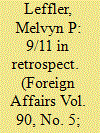

|
|
|
| 2 |
ID:
114985
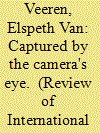

|
|
|
|
|
| Publication |
2011.
|
| Summary/Abstract |
In January 2002, images of the detention of prisoners held at US Naval Station Guantanamo Bay as part of the Global War on Terrorism were released by the US Department of Defense, a public relations move that Secretary of Defense Donald Rumsfeld later referred to as 'probably unfortunate'. These images, widely reproduced in the media, quickly came to symbolise the facility and the practices at work there. Nine years on, the images of orange-clad 'detainees' - the 'orange series' - remain a powerful symbol of US military practices and play a significant role in the resistance to the site. However, as the site has evolved, so too has its visual representation. Official images of these new facilities not only document this evolution but work to constitute, through a careful (re)framing (literal and figurative), a new (re)presentation of the site, and therefore the identities of those involved. The new series of images not only (re)inscribes the identities of detainees as dangerous but, more importantly, work to constitute the US State as humane and modern. These images are part of a broader effort by the US administration to resituate its image, and remind us, as IR scholars, to look at the diverse set of practices (beyond simply spoken language) to understand the complexity of international politics.
|
|
|
|
|
|
|
|
|
|
|
|
|
|
|
|
| 3 |
ID:
148052
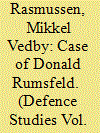

|
|
|
|
|
| Summary/Abstract |
Taking its point of departure in Donald Rumsfeld’s second term as US Secretary of Defense (2001–2006), this article analyses the crisis of strategic leadership in Western national security. Three “traps” are identified that explain why Donald Rumsfeld ultimately was a failure as defence secretary and demonstrate the perils of national security governance. These traps are termed the inquisitor trap, the strong leader trap and the delegation trap. It is argued that our understanding of strategic leadership in national security, particularly in defence, can benefit from insights gained from the study of strategic leadership in business. As such, this article engages the recent trend of merging insights from business and military strategy.
|
|
|
|
|
|
|
|
|
|
|
|
|
|
|
|
| 4 |
ID:
122393
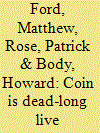

|
|
|
|
|
| Publication |
2012.
|
| Summary/Abstract |
Donald Rumsfeld was right. Force transformation works. The techniques
that led to the initial victories in Afghanistan in 2001 were precisely those
that produced success in Libya in 2011.1
Small-scale deployments of special
forces backed by precision strike and deep attack capabilities used to support an
allied indigenous armed group proved an effective military tool for achieving
specific strategic outcomes. In contrast, the results of large-scale troop deployments as part of counterinsurgency (COIN), stabilization and nation-building
activities over the past 1ten0 years in Iraq and Afghanistan have been less definitive. Despite intensive investment in blood, treasure, and military effort, the
precise long-term outcomes of these two campaigns remain unclear and will
be open to debate for years to come. This challenging operational experience
has, however, highlighted some necessary and enduring truths about the use of
military force. Despite great advances in military technology and the increasing
sophistication with which organized violence can be applied in a range of situations, all warfare remains characterized by uncertainty; there exists no silver
bullet that can guarantee enduring political success from the barrel of a gun.2
|
|
|
|
|
|
|
|
|
|
|
|
|
|
|
|
| 5 |
ID:
131465
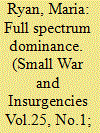

|
|
|
|
|
| Publication |
2014.
|
| Summary/Abstract |
This article examines the evolution of US irregular warfare (IW) doctrine and practice from 2001 onwards. It argues that, after 9/11, top-tier civilian policymakers in the US Department of Defense (DoD) and across the US government developed a heightened awareness of asymmetric threats and non-conventional forms of warfare, especially those shaped by contemporary globalisation. The result was a gradual turn towards irregular warfare, led by Rumsfeld and the DoD, designed to ensure 'full spectrum dominance' across all modes of conflict. This pre-dated the insurgency in Iraq and the promotion of counterinsurgency in the US Army by General David Petraeus and others. Policymakers' reluctance to acknowledge the insurgency in Iraq was not down to a failure to understand the concept of IW, but because they had viewed Iraq in conventional terms for so many years and were reluctant to admit their mistake.
|
|
|
|
|
|
|
|
|
|
|
|
|
|
|
|
| 6 |
ID:
124170
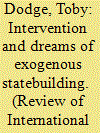

|
|
|
|
|
| Publication |
2013.
|
| Summary/Abstract |
The central thesis of this article is that when faced with state collapse, rising violence, and a complex stabilisation effort, the US, UN, and NATO in Afghanistan and the US and Britain in Iraq, deployed the dominant, if not only, international approach available, Liberal Peacebuilding. The article traces the rise of Liberal Peacebuilding across the 1990s. It argues that four units of analysis within neoliberal ideology, the individual, the market, the role of the state and democracy, played a key role within Liberal Peacebuilding, allowing it to identify problems and propose solutions to stabilise post-conflict societies. It was these four units of analysis that were taken from the Liberal Peacebuilding approach and applied in Afghanistan and Iraq. The application of a universal template to two very different countries led directly to the fierce but weak states that exist today.
|
|
|
|
|
|
|
|
|
|
|
|
|
|
|
|
|
|
|
|
|